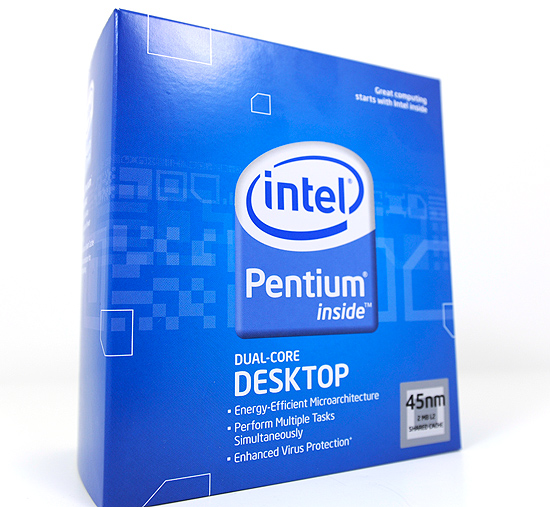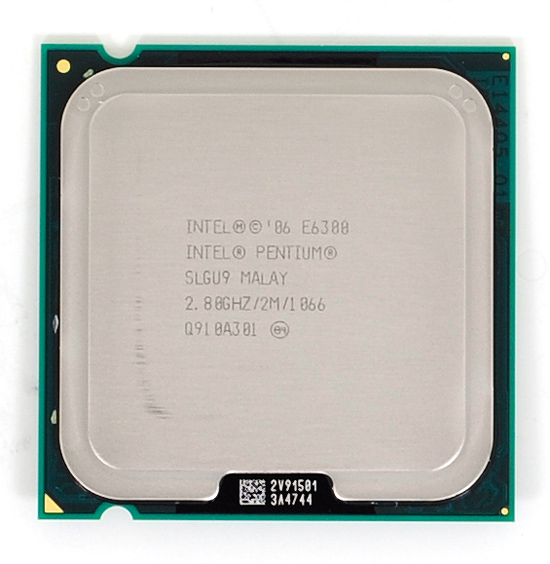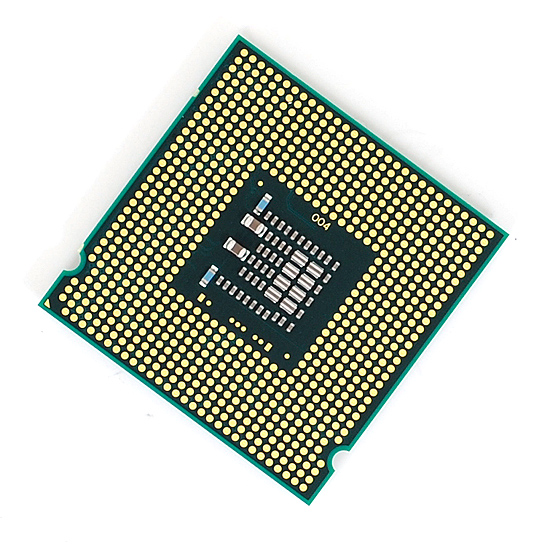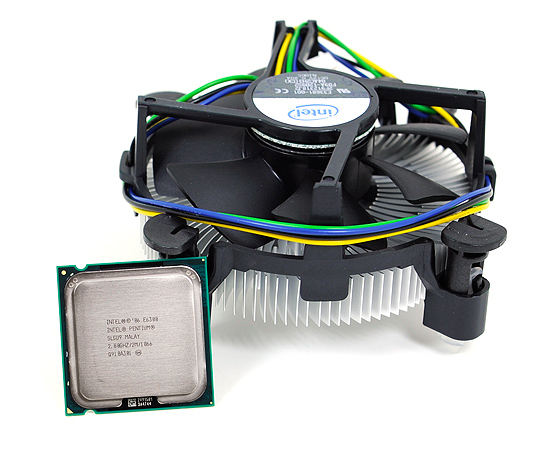The Athlon II X2 & Phenom II X2: 45nm Dual-Core from AMD
by Anand Lal Shimpi on June 2, 2009 12:00 AM EST- Posted in
- CPUs
Intel’s Response: The Pentium E6300
AMD has two new dual-core chips priced at $87 and $102, both run at or around 3.0GHz and have a fair amount of cache. The Athlon II X2 250 has a 1MB L2 per core (2MB total) while the Phenom II X2 550 BE has a large 6MB L3 to share between its two cores. These are both very healthy sounding processors, borderline scary if you’re Intel.

The Pentium E6300
In the blue corner we have the new Pentium E6300. It’s a 45nm monolithic dual-core part, just like the Athlon II X2. It has a 2MB L2 cache also like the Athlon II X2, albeit shared between the two cores which is potentially an upside. Unlike previous Pentium for Desktop (that’s the official name) processors, the E6300 uses a 1066MHz FSB and it supports Intel’s VT. The problem? The E6300 only runs at 2.80GHz; AMD has a clock speed advantage.


In our first Phenom II review I talked about how AMD needs a clock speed advantage to compete. Compared to a large-cache Core 2, that’s very true, but the E6300 doesn’t have a healthy 6MB L2 for two cores. It’s only got 2MB. All of the sudden things aren’t looking so rosy for Intel.

An inherent advantage of Intel’s Core architecture is its 4-issue front end (which in some cases can behave like a 5-issue front end). The problem is feeding such a beast requires very fast memory access. The Pentium E6300 is still based on the same architecture as the Core 2 Duo, meaning it has no on-die memory controller. Rob it of a decent sized cache and its performance suffers. A quick look at Bench shows us that even an extra megabyte of cache helps tremendously:
| Processor | SYSMark 2007 Overall |
| Intel Core 2 Duo E7500 (2.93GHz/3MB L2) | 173 |
| Intel Pentium E6300 (2.80GHz/2MB L2) | 158 |
Note that when Conroe first launched some parts (the Core 2 Duo E6300 funny enough) only had a 2MB L2. The problem is that was nearly three years ago; applications have grown in size and so have their demands from processors. What was acceptable back then is now not. I’d like to see Intel move its 3MB L2 caches down to these sub-$100 price points. But I’ll let the benchmarks decide whether or not it’s necessary.
| Processor | Clock Speed | L2 Cache | TDP | Price |
| Intel Core 2 Quad Q9650 | 3.00GHz | 12MB | 95W | $316 |
| Intel Core 2 Quad Q9550 | 2.83GHz | 12MB | 95W | $266 |
| Intel Core 2 Quad Q9400 | 2.66GHz | 6MB | 95W | $213 |
| Intel Core 2 Quad Q9300 | 2.50GHz | 6MB | 95W | $213 |
| Intel Core 2 Quad Q8400 | 2.66GHz | 4MB | 95W | $183 |
| Intel Core 2 Quad Q8300 | 2.50GHz | 4MB | 95W | $183 |
| Intel Core 2 Quad Q8200 | 2.33GHz | 4MB | 95W | $163 |
| Intel Core 2 Duo E8600 | 3.33GHz | 6MB | 65W | $266 |
| Intel Core 2 Duo E8500 | 3.16GHz | 6MB | 65W | $183 |
| Intel Core 2 Duo E8400 | 3.00GHz | 6MB | 65W | $163 |
| Intel Core 2 Duo E7500 | 2.93GHz | 3MB | 65W | $133 |
| Intel Core 2 Duo E7400 | 2.80GHz | 3MB | 65W | $113 |
| Intel Core 2 Duo E7300 | 2.66GHz | 3MB | 65W | $113 |
| Intel Pentium E6300 | 2.80GHz | 2MB | 65W | $84 |
| Intel Pentium E5400 | 2.70GHz | 2MB | 65W | $84 |
| Intel Pentium E5300 | 2.60GHz | 2MB | 65W | $74 |
| Intel Pentium E5200 | 2.50GHz | 2MB | 65W | $64 |
| Intel Pentium E2220 | 2.40GHz | 1MB | 65W | $64 |
| Intel Pentium E2200 | 2.20GHz | 1MB | 65W | $64 |
| Intel Celeron E1500 | 2.20GHz | 512KB | 65W | $53 |
| Intel Celeron E1400 | 2.00GHz | 512KB | 65W | $43 |
| Intel Celeron 450 | 2.20GHz | 512KB | 35W | $53 |
| Intel Celeron 440 | 2.00GHz | 512KB | 35W | $44 |
| Intel Celeron 430 | 1.80GHz | 512KB | 35W | $34 |










55 Comments
View All Comments
7Enigma - Thursday, June 4, 2009 - link
Hello Anand,In the article you seem to imply a tremendous difference in that 2meg to 3meg jump but your single data point doesn't show that conclusion.
In your example there is a ~9% increase in performance when going from 2 to 3 megs, but there is also a 4.5% increase in clockspeed between the 2 chips. So at best (in this example) you have a 5% difference, which while significant, I would't say it was tremendous.
Can you comment on whether you did any further tests with identical frequencies?
FlameDeer - Thursday, June 4, 2009 - link
Here are some corrections of AnandTech Bench.Refer to here:
http://www.anandtech.com/bench/default.aspx?b=25&a...">Adobe Photoshop CS4 results of few CPUs from AnandTech Bench
1. AMD Athlon II X2 250 results missing a dot, becoming slower than Intel Atom 230.
2. Better using "Intel Pentium Dual Core E5300" for E5300 as the name Intel printed on the CPU.
3. AMD Athlon LE-1620 notes (platform side notes) should be same as AMD Athlon LE-1640.
Thanks for adding more CPUs for comparison in AnandTech Bench, doing the full test in latest software is really time consuming especially for old CPUs. Take care.
MadAd - Wednesday, June 3, 2009 - link
would have liked to see phenom (non II) compared, especially the low end x3s, users may be thinking of upgrading from those about nowFlameDeer - Thursday, June 4, 2009 - link
You can always conveniently & interactively comparing them here.http://www.anandtech.com/bench/">AnandTech Bench
Elementalism - Wednesday, June 3, 2009 - link
I never had much luck running Cool n Quiet when I used to run AMD processors. Even in games the CPU was put into a low clock mode running at half speed. Sounds like a buggy implementation to this day.And I cant say in my experience it was the Mother Boards fault either. I enabled Cool and Quiet in the bios and nothing happened. It wasnt until I installed the Cool n Quiet driver all hell broke loose.
mino - Wednesday, June 3, 2009 - link
However one has to keep in mind the bug comes from Redmond.The Win 5.x scheduler is a piece of garbage and it allways was. It is just that it shows with different symptoms:
1 CPU core => crappy multi-tasking on heavy loads
2+ CPU cores => unable to get a grasp that power management not a thing of the future ...
A no, being from 2000 is no excuse, proper OS scheduler were there 30yrs ago.
Had MS decided to do so, their Win 5.x schedules would be a proper one from the start.
As for AMD, it is a price one pays for being ahead of the market.
Remember, it took Intel 5yrs (2003-2008) to get comparable power management capabilities as AMD with Nehalem.
mino - Wednesday, June 3, 2009 - link
sorry for the spelling mess..Hrel - Wednesday, June 3, 2009 - link
YAY 3D max, also that E7500 is beating the crap out of everything but AMD's top of the line. That really solitifies in my mind that picking the E8400 6 months ago for my friends gaming computer was the right choice. Stupid AMD, I REALLY want them to be competitive again so Intel is FORCED to stop overcharging for EVERYTHING.mmpalmeira - Wednesday, June 3, 2009 - link
Did you try to overclock the uncore of the AMD's CPUs?calyth - Tuesday, June 2, 2009 - link
Just like that article that you linked to with the name CnQ bug, I don't believe that a hardware manufacturer creates a bug if the OS scheduler can't seem to do the sensible thing and not bounce threads around. Although various factors in the AMD chips make the problem worse, bouncing threads across different cores on an Intel chip also has a bit of impact, since L1 and the L2 shouldn't be shared across cores on the i7 platform.So please, stop calling it a bug. The bug lies in Windows, not the chips.